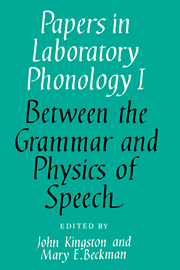Book contents
- Frontmatter
- Contents
- List of contributors
- Acknowledgements
- 1 Introduction
- 2 Where phonology and phonetics intersect: the case of Hausa intonation
- 3 Metrical representation of pitch register
- 4 The status of register in intonation theory: comments on the papers by Ladd and by Inkelas and Leben
- 5 The timing of prenuclear high accents in English
- 6 Alignment and composition of tonal accents: comments on Silverman and Pierrehumberf's paper
- 7 Macro and micro F0 in the synthesis of intonation
- 8 The separation of prosodies: comments on Kohler's paper
- 9 Lengthenings and shortenings and the nature of prosodic constituency
- 10 On the nature of prosodic constituency: comments on Beckman and Edwards's paper
- 11 Lengthenings and the nature of prosodic constituency: comments on Beckman and Edwards's paper
- 12 From performance to phonology: comments on Beckman and Edwards's paper
- 13 The Delta programming language: an integrated approach to nonlinear phonology, phonetics, and speech synthesis
- 14 The phonetics and phonology of aspects of assimilation
- 15 On the value of reductionism and formal explicitness in phonological models: comments on Ohala's paper
- 16 A response to Pierrehumbert's commentary
- 17 The role of the sonority cycle in core syllabification
- 18 Demisyllables as sets of features: comments on Clements's paper
- 19 Tiers in articulatory phonology, with some implications for casual speech
- 20 Toward a model of articulatory control: comments on Browman and Goldstein's paper
- 21 Gestures and autosegments: comments on Browman and Goldstein's paper
- 22 On dividing phonetics and phonology: comments on the papers by Clements and by Browman and Goldstein
- 23 Articulatory binding
- 24 The generality of articulatory binding: comments on Kingston's paper
- 25 On articulatory binding: comments on Kingston's paper
- 26 The window model of coarticulation: articulatory evidence
- 27 Some factors influencing the precision required for articulatory targets: comments on Keating's paper
- 28 Some regularities in speech are not consequences of formal rules: comments on Keating's paper
- Index of names
- Index of subjects
12 - From performance to phonology: comments on Beckman and Edwards's paper
Published online by Cambridge University Press: 08 February 2010
- Frontmatter
- Contents
- List of contributors
- Acknowledgements
- 1 Introduction
- 2 Where phonology and phonetics intersect: the case of Hausa intonation
- 3 Metrical representation of pitch register
- 4 The status of register in intonation theory: comments on the papers by Ladd and by Inkelas and Leben
- 5 The timing of prenuclear high accents in English
- 6 Alignment and composition of tonal accents: comments on Silverman and Pierrehumberf's paper
- 7 Macro and micro F0 in the synthesis of intonation
- 8 The separation of prosodies: comments on Kohler's paper
- 9 Lengthenings and shortenings and the nature of prosodic constituency
- 10 On the nature of prosodic constituency: comments on Beckman and Edwards's paper
- 11 Lengthenings and the nature of prosodic constituency: comments on Beckman and Edwards's paper
- 12 From performance to phonology: comments on Beckman and Edwards's paper
- 13 The Delta programming language: an integrated approach to nonlinear phonology, phonetics, and speech synthesis
- 14 The phonetics and phonology of aspects of assimilation
- 15 On the value of reductionism and formal explicitness in phonological models: comments on Ohala's paper
- 16 A response to Pierrehumbert's commentary
- 17 The role of the sonority cycle in core syllabification
- 18 Demisyllables as sets of features: comments on Clements's paper
- 19 Tiers in articulatory phonology, with some implications for casual speech
- 20 Toward a model of articulatory control: comments on Browman and Goldstein's paper
- 21 Gestures and autosegments: comments on Browman and Goldstein's paper
- 22 On dividing phonetics and phonology: comments on the papers by Clements and by Browman and Goldstein
- 23 Articulatory binding
- 24 The generality of articulatory binding: comments on Kingston's paper
- 25 On articulatory binding: comments on Kingston's paper
- 26 The window model of coarticulation: articulatory evidence
- 27 Some factors influencing the precision required for articulatory targets: comments on Keating's paper
- 28 Some regularities in speech are not consequences of formal rules: comments on Keating's paper
- Index of names
- Index of subjects
Summary
Beckman and Edwards have presented experimental evidence for the association of syllabic lengthening in speech with two phonological effects. One is the presence of an intonational phrase boundary. Lengthening associated with intonational phrase boundaries occurs consistently across speakers and speech rates. The other effect is the presence of a word boundary. In contrast to phrase-final lengthening, word-final lengthening occurs inconsistently. It is more evident at a slow rate of speech; even then, not all speakers show it with all sentences.
Beckman and Edwards's aim in examining the occurrence of lengthening effects is to make claims about the proper model of English phonological structure. They relate their experiments to a long tradition of phonological interpretation of timing effects in speech, with two separate (and as Beckman and Edwards point out, at least in part incompatible) strands: lengthening which is claimed to accompany the terminal boundary of a phonological unit, and shortening which is claimed to adjust the interval between stressed syllables in the direction of greater regularity. The effects which Beckman and Edwards found in their experiments are of the first sort.
This commentary concerns the assumptions on which undertakings such as Beckman and Edwards's are based. Precisely how does a speaker's performance shed light on the phonology of a language?
Two useful distinctions may be drawn. The first is between what one may call a strong and a weak version of the claim to “psychological reality.”
Information
- Type
- Chapter
- Information
- Papers in Laboratory Phonology , pp. 208 - 214Publisher: Cambridge University PressPrint publication year: 1990
